
Alexandria and the War of 1812
Alexandria and the War of 1812

The war of 1812, and the five-day occupation of Alexandria by British forces in 1814, had a profound effect on the town and its economy. While war was declared in 1812, it was not until 1814 that it reached Alexandria's shores. On August 29 Alexandrians awoke to find 138 guns of the British squadron "but a few hundred yards from the wharves, and the houses so situated at they might have been laid in ashes in a few minutes," as described by the residents. The British promised not to destroy the town if the citizens surrendered all naval stores, shipping, and merchandise being exported. Alexandria agreed, under much scrutiny by the nation. However, it was thanks to the actions on both sides that the "Old Town" of today is still preserved.
Star-spangled Banner Trail
Three signs are located in Alexandria as part of the Star-Spangled Banner Trail, developed by the National Park Service, commemorate the War of 1812.
- Raise the White Flag is installed in Waterfront Park.
- Plundered is located in the Torpedo Factory arcade, near the Timeline.
- Fighting Back is at the base of Shuter's Hill, across from the Callahan Drive crosswalk.
First Person Accounts of Alexandria and the War of 1812
Terms of Capitulation
Threatened with an invasion and with insufficient forces to defend the city, Alexandria’s Common Council surrendered to the British without resistance. The city avoided being burned, but was required to surrender contents of stores and warehouses. According to the terms of capitulation, "The town of Alexandria, with the exception of public works, shall not be destroyed, unless hostilities are commenced on the part of the Americans; nor shall the inhabitants be molested in any manner whatever, or their dwelling-houses entered, if the following articles are complied with . . . "
Copy of a letter from the Mayor of Alexandria to the Mayor of Georgetown
Dear Sir,
Enclosed is a copy of the terms proposed to the common council of Alexandria, by the commanding officer of the squadron now lying before the town, to which they were compelled to submit.
Charles Simms
Terms of Capitulation. His majesty’s ship Sea Horse, off Alexandria, 29th August, 1814.
Gentlemen -In consequences of a deputation yesterday received from the city of Alexandria, requesting favorable terms for the safety of the city, the under mentioned are the only conditions in my power to offer. The town of Alexandria, with the exception of public works, shall not be destroyed, unless hostilities are commenced on the part of the Americans, nor shall the inhabitants be molested in any manner whatever, or their dwelling houses entered, if the following articles are complied with:
- All naval and ordinance stores, public or private, must immediately be delivered up.
- Possession will be immediately taken of all the shipping, and their furniture must be sent on board by the owners without delay.
- The vessels that have been sunk must be delivered up in the state they were, on the 19th of August, the day the squadron passing the Kettle Bottoms.
- Merchandise of every description must be instantly delivered up, and to prevent any irregularity, that might be committed in its embarkation, the merchants have it at their option to load the vessels generally employed for that purpose, when they shall be towed off by us.
- All merchandise that has been removed from Alexandria, since the 19th inst. is to be included in the above articles.
- Refreshments of every description to be supplied [to] the ships, and paid for at the market price, by bills of the British government.
Officers will be appointed to see that article No. 2, 3, 4 and 5, are strictly complied with, and any deviation of non-compliance, on the part of the inhabitants of Alexandria, will render this treaty null and void.
I have the honor to be, John A. Gordon, Captain of H.M. ship Sea Horse, and senior officer of H.M. ships off Alexandria. To the Common Council of the town of Alexandria.
George Robert Gleig, British Soldier
The War of 1812 had a direct impact on Alexandria, when British forces occupied the city for five days, from August 29 through September 2, 1814. A few days earlier, on August 23, the British troops had set fire to Washington. A British soldier wrote:
... this was a night of dismay to the inhabitants of Washington. They were taken completely by surprise... The first impulse of course tempted them to fly, and the streets were in consequence crowded with soldiers and senators, men, women, and children, horses, carriages, and carts loaded with household furniture, all hastening toward a wooden bridge which crosses the Potomac... Of the senate-house, the President's palace, the barracks, the dockyard, etc., nothing could be seen, except heaps of smoking ruins; and even the bridge, a noble structure upward of a mile in length, was almost wholly demolished.
George Robert Gleig, A Narrative of the Campaign of the British Army at Washington and New Orleans, 1814.
Charles Simms, Mayor of Alexandria
It is impossible that men could behave better than the Britissh [sic] behaved while the town was in their power, not a single inhabitant was insulted or injured by them in their person or houses.
Joseph F. Skivora, “The Surrender of Alexandria in the War of 1812 and the Power of the Press,” Northern Virginia Heritage, June 1988, citing Mayor Charles Simms in a letter to his wife.
Edward Stabler
Their conduct was respectful and decorous; and instead of that exultation and triumph which expands the heart of a soldier when he encounters and overcomes a force like his own, these were evidently dejected and adverse to what they were doing.
Joseph F. Skivora, “The Surrender of Alexandria in the War of 1812 and the Power of the Press,” Northern Virginia Heritage, June 1988, citing a letter from Edward Stabler to other Alexandria Quakers.
Reminiscences of the Occupation, from The Local News, 1861
from The Local News, November 23, 1861
... The troops and citizens of Alexandria, capable of bearing arms, had been ordered from the place, and were nineteen miles off on the day the squadron came opposite the town; and the Fort below, where it was expected that the passage up the river, of the British vessels, would have been, at least, disputed, was abandoned by the U.S. forces, and blown up. The explosion reverberated through the streets of Alexandria and announced to the town its fate as a captured city . . . To their credit, be it said, the British observed strictly, on their part, the terms of the capitulation. The inhabitants were personally not molested in any manner whatever, nor their dwellings ever entered. Their municipal and police authorities and regulations were never disturbed nor interfered with, in the slightest degree. Discipline was enforced, without an exception, for such a spectacle as a drunken or disorderly British soldier, marine, or sailor was never seen in the streets – nor, is it believed, that one of them ever came up town farther than Washington Street. The flour and tobacco captured and seized, were removed to the lighters in the docks by the sailors, who dragged the drays – and a quantity of flour, the barrels holding which were broken, was given to the poor of the town. The officers appeared to be gentlemen, with the feelings of gentlemen, and never failed to express their sympathy with the inhabitants, at the condition to which they had been reduced, and never turned a screw for pressure, beyond what their duty, under the terms of surrender, (and they were hard enough) required . . . .
The British had been here for a day or two, the town surrendered and given up by capitulation, and the fleet moored, as I have said, but a few hundred yards from the wharves. A barge had been sent on shore for some purpose or other, under the charge of a midshipman, and came into the dock at the foot of Prince street. The seamen were listlessly lounging about, and the officer, having executed his commission on shore was sauntering leisurely back to the boat. Just at this moment the clattering of horses hoofs were heard on Union street, and Captain Creighton, of the U.S. Navy, with a few others accompanying him, dashed by. – Creighton, seeing the middy in the streets, seized him by the black leather neck-stock which he wore, and attempted to drag him on his horse intending to carry him out as a prisoner and a “trophy.” Fortunately for the British officer, the string fastening the two ends of the stock broke, and he fell to the ground, when, recovering himself instantly he darted for his boat, jumped in, followed by his men, and pulled out instantly to the Sea Horse. It was all the work of a minute. Creighton’s horse had hardly paused in its career, and by the time the boat had left the head of the dock, he was in full gallop up Duke Street. This was a gallant and daring adventure, but an imprudent one . . . The midshipman had no sooner reported the affair to his superior officers, than the drums on the British vessels beat to quarters – the port holes were opened – and every preparation made to fire upon the town. And then, the old inhabitants recollect, there was such a stampede as was never before witnessed. The women and children, and the few men who had remained, started for flight, and long trains were seen going out of the principal streets, laden with every description of property that could be, in our old Virginia phrase, “toated.” It was a steady stream for some time, most persons expecting every minute to see the shot and shells of the enemy falling upon the houses, and decimating the flying crowd. However, a deputation was immediately sent off to Captain Gordon, the affair explained, and all further proceedings in the matter dropped. The inhabitants being reassured soon ceased to leave town – those who had gone returned, and everything was restored to the former condition.
There was, during the occupation of the town, almost an entire cessation of business. Many stores and shops, however, remained open. The publication of the Alexandria Gazette was then suspended for two weeks, I think – the first and only time . . . .
When the fleet left Alexandria, with their captured property, and proceeded down the river, they found they were not to go “scot free.” Com. Rogers, “with boats and fire vessels, attacked and annoyed their rear,” and they had to pass the gauntlet at the White House, where a battery had been erected by Com. Perry and Capt. Creighton, and where the Alexandria artillery . . . so behaved, as to receive great praise . . .
An anonymous author’s reminiscences upon visiting Alexandria after a thirty year absence, entitled “Reminiscences of an Old Bachelor,” were serialized in the Alexandria newspaper The Local News in 1861-1862.
Objects from the Collection
About the Collection
War of 1812 objects in the museum collections include a carronade and sword and scabbard in the collection of the Alexandria History Museum at The Lyceum, and commemorative ceramics in the collection of the Alexandria Archaeology Museum.
The Carronade

This Carronade was apparently used in Alexandria on an American gunboat during the War of 1812. It was recovered from the muddy shoreline in the vicinity of where Hunting Creek and the Potomac River converge, and is believed to have been scuttled by Americans in 1814 when British forces seized Alexandria.
Carronades were first introduced and manufactured in Scotland by the Carron Company, in 1779. They were designed specifically to require minimal effort in moving, loading and firing. Their light weight and short barrels made them immediately practical on board ships. Although the firing range was very short, they were particularly effective in destroying the rigging of enemy ships. With the versatility of long range guns and continued sophistication of naval weaponry, the carronades were soon restricted to augmenting a ship’s artillery. By 1860, most carronades became virtually obsolete.
Sword and Scabbard

Sword and Scabbard, 1814, Mark: J. Gaither for Alexandria silversmith John Gaither, Silver, Ivory, Iron, Leather. The initials and infantry number for Lieutenant C.I. Queen of the 36th Infantry are scratched on the sword’s knuckle guard. During the War of 1812, this unit participated in the Battle of Bladensburg and the defense of Fort McHenry in Baltimore.
Commemorative Ceramics
A number of ceramics celebrating the end of the war and honoring its heroes were found on archaeological sites in Alexandria, and are in the collection of the Alexandria Archaeology Museum. Alexandria's taverns, in particular, had many patriotic pieces, including a set of small shell-edged plates depicting the American Eagle (the Great Seal of the United States). Both Arell’s Tavern and Gadsby’s Tavern had creamware pitchers depicting Peace, Plenty and Independence and McKnight’s Tavern had a creamware pitcher depicting a ship under sail. These designs celebrated the resumption of trade following the Treaty of Ghent. From nearby residential sites, archaeologists recovered pitchers celebrating “Peace and Plenty,” "Peace, Plenty and Independence," and “Virtue and Valour,” and honoring war heroes General Zebulon Pike and Captain Jacob Jones.
Read about these objects and more in Commemorative Ceramics in George Washington's Hometown.
Eagle Plate

Pearlware plate, England, ca. 1815–1830. A number of ceramics celebrating the end of the war and honoring its heroes have been found at archaeological excavations in Alexandria, many at tavern sites. Arell’s Tavern, in particular, used many patriotic pieces, including a set of small shell-edged plates with an “even scallop” pattern and depicting the American eagle. While this motif appears on wares made before the Embargo of 1807, it was commonly used following the end of the War of 1812. These dishes were popular among the lower and middle classes, and therefore were appropriate for Arell’s, a working-class tavern. Another blue shell-edged eagle plate was found at McKnight’s Tavern, which was known by its sign of the spread eagle.
Peace and Plenty Pitcher

“Cameo jasper” refined stoneware pitcher, England, ca. 1815. The Great Seal is depicted on one side, and Miss Liberty on the other. Peace is represented by the caduceus and hands clasped in friendship, Plenty by the overflowing cornucopia. This pitcher celebrates the Treaty of Ghent, which was signed on Christmas Day 1814.
Peace, Plenty and Independence Pitcher

Many variations of the popular print Peace, Plenty and Independence appeared on creamware and pearlware pitchers made for the American market by the Staffordshire potters Enoch Wood and Sons, Herculaneum, and others. The print depicts the spread eagle perched atop a cannon, beneath which is a circle with the slogan “Peace, Plenty and Independence.” There is a female figure at right, Peace, who torches the tools of war; a figure at left, Plenty, holds a sheaf of wheat and a cornucopia. These creamware fragments were found at the site of Arell's Tavern.
By Virtue and Valor Pitcher

This creamware pitcher commemorating the end of the War of 1812 depicts a soldier standing on a lion—representing Britain—and gesturing toward a merchant ship under sail. American flags and weapons of war ornament the cartouche. Many different versions of this print appear on pitchers, bowls, and plates, and each usually includes the words “By Virtue and Valour We Have Freed Our Country, Extended Our Commerce, and Laid the Foundation of a Great Empire.
More Resources
- Alexandria and the War of 1812. A 12-part series published July-September 2014 in the Alexandria Gazette. By Ted Pulliam, historian and member of the Alexandria Archaeological Commission.
- Discovering the Decades: The 1810s, by Timothy Denee and T. Michael Miller, in Alexandria Archaeology Volunteer News (1999).
- "A British Fleet Sails into Alexandria," by Ted Pulliam; "A Defenseless Alexandria", by Carole L. Herrick (Fall 2007). The Alexandria Chronicle (Spring 2009), a publication of the Alexandria Historical Society.
- Alexandria in the War of 1812. Alexandria History Magazine (1984), pp. 16-23, a publication of the Alexandria Historical Society.
- The Internal Enemy: Slavery and War in Virginia, 1772-1832. C-Span video and transcriptions, September 24, 2013. Alan Taylor talked about his book, in which he recounts the impact that slaves in Virginia had on the War of 1812. In his book, the author reports that upon the British invasion, slaves in Virginia sought their freedom by escaping to British ships moored in the Chesapeake Bay. Once aboard they imparted their understanding of local geography to assist the British Army. Alan Taylor spoke at Thomas Jefferson’s Monticello in Charlottesville, Virginia. The Internal Enemy was a finalist for the 2013 National Book Award for non-fiction. In May, 2014, Professor Taylor spoke at The Lyceum, connecting his research for this book with Alexandrians’ own experiences during the War of 1812. The Internal Enemy is for sale at The Historic Alexandria Museum Store at The Lyceum. Check to see if it is in stock.